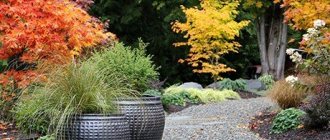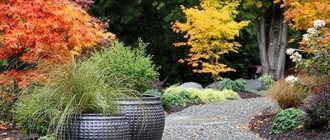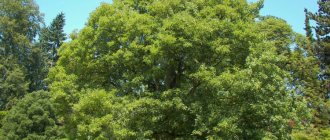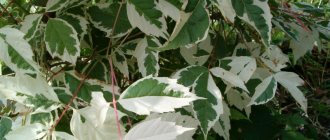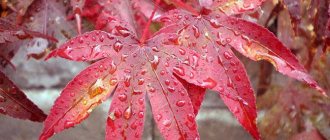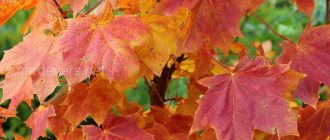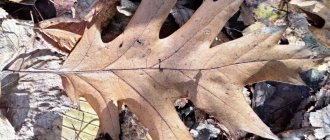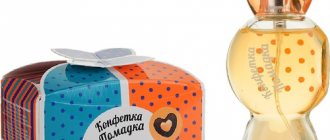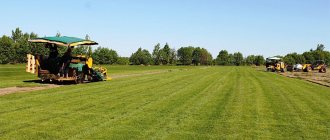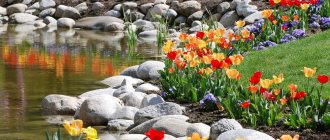Japanese maples with red leaves are widely known and loved by many gardeners. But, unfortunately, in the middle zone their wintering causes many problems. However, not only Japanese maples with burgundy foliage or varietal varieties of Norway maple are called red. There is another type of maple, which has a botanical name - red maple. So far it is not widely used in landscape design, which is undeserved. After all, this tree is decorative all four seasons of the year, and at the same time it is completely winter-hardy. Let's learn more about red maple.
Red maple - attractive at any time of year
Red maple - botanical information
Red maple (Acer rubrum) is a deciduous tree from the Maple family, reaching a height of 9 to 28 meters in maturity. The plant's homeland is the United States of America, where it is widespread and, along with sugar maple, is used to produce maple syrup.
The leaves are palm-shaped, toothed, palmate-lobed, typical for maples, 5-10 cm long. In the summer, their color is bright green with a grayish reverse side, and they acquire a bright red color in the fall. Young red maples have smooth, light gray bark, but with age it begins to crack into separate plates, becoming dark gray, rough and furrowed. The tree is monoecious and both male and female flowers can be seen on the same plant.
Flowering begins in March-April, with flowers appearing before leaves. Male flowers are bright red, have long stamens with yellow anthers that extend beyond the perianth. In female flowers of the same color, you can see a long stigma. From the female flowers, fruits later appear in the form of “helicopters” characteristic of maples, that is, lionfish 15-25 mm long. The root system of the plant is shallow and wide.
Red maple is able to adapt well to various growing conditions. In the wild, it can be found in mixed forests, both in swampy areas and on poor soils in dry areas. This tree is a long-liver, its lifespan is 100-200 years.
Red maple (Acer rubrum). © Ponderosa
Where and how does it grow
- The natural habitat of this maple is Asia: it used to be and is now widespread in northeastern China, Japan, Korea and Mongolia.
- Many scientists, by the way, combine the Tatarian maple (a tree whose photo is identical to the hero of the article) and the Ginnala maple into one subspecies.
- But still, the second true name of the Ginnala maple is riverine maple, or riverside maple Ginnala. He received it due to the fact that he most often “settled” on the banks of rivers. Sometimes you can find maple in mountainous areas, as well as in light forests.
- Life expectancy is very high - up to 100 years, and there are specimens that are already more than 200 years old!
- Maple grows quite quickly, adding 20-50 cm in height and width every year.
- The qualities of the Ginnala maple are light-loving, unpretentious, frost-resistant, wind-resistant.
Decorative advantages of red maple
The outstanding ornamental characteristic of the red maple is the red, crimson, orange or yellow color of its fall foliage. And such an extravaganza of color can be observed for several weeks. At the same time, the red maple is one of the first trees to color in the fall; it decorates the garden with its bright foliage for a long time. Sometimes on one tree you can see all possible shades of color - from bright red to yellow. But in varietal forms the coloring is more uniform, and you can find variations with only a red or only a yellow crown.
It is not for nothing that such a maple is called red, because this species has red not only autumn leaves. In spring, young red maple foliage also has reddish hues. With the arrival of summer, the leaves turn green, but their petioles remain red. Young lionfish (which set in spring before the leaves are fully developed and continue to mature until autumn) are also bright crimson. And even the buds of this maple are reddish!
Thus, the red maple can be called a tree of four seasons. In summer, it features beautiful green leaves with deep lobes and a silver-gray underside with colorful red petioles and young winglets.
In autumn, red maple foliage turns into a veritable kaleidoscope, combining combinations of burgundy, red, yellow and orange. And an additional decoration is “helicopter” seeds.
In winter we see an oval silhouette, reddish buds and rough bark of a noble shade. Additionally, young maple shoots have a bright olive green color, and cultivars may also have reddish tones.
And even in spring the tree looks wonderful. The most remarkable decoration is the bright red flowers “burning” on bare branches, and the blooming reddish young leaves.
In autumn, the green foliage of the red maple takes on vibrant hues. © Jim M. Hollister
Spreading
The North American continent is the birthplace of the Canadian maple. Widely distributed in Canada and the eastern United States, where it gets its name. It grows mainly in deciduous and mixed forests or in damp lowlands along the banks of reservoirs. It can rarely be found at higher elevations. Unpretentious to the local landscape. It can even withstand floods. Prefers proximity to birch, poplar, linden and beech trees.
Many varieties were cultivated in Russia. They are widespread throughout our country. Especially those species that are frost-resistant. In some regions, due to its reproductive characteristics, the Canadian maple grows as a weed, so it is necessary to combat the small growth of this plant.
Red maple varieties
Individual specimens of red maple vary greatly in color and color intensity. Varieties differ from the species plant mainly in that they are more uniformly colored, but can also have different habit. Most modern varieties turn bright crimson red in the fall, but some varieties may have fall foliage that turns orange or yellow. Also, varietal specimens are more compact and not as tall as species.
Note: Some varieties of red maple are classified as Freeman's maple (Acer freemanii). This is a hybrid of red maple and silver maple (A. rubrum X A. saccharinum), which has absorbed the best features of both parents.
The Autumn Blaze maple is a Freeman maple, a hybrid of red and silver maple. The positive traits that he inherited from his parents are the bright color of autumn foliage, a thick dense crown and a surprisingly high growth rate. This variety is one of the most popular varieties of red maples among landscape designers. The variety is tall and will grow up to 20 meters. The crown is initially conical, later broadly oval.
The Schlesingeri maple is distinguished by the fact that its young growths have a bright red-brown color and serve as a winter decoration for the site. The tree is of medium size, its height (adult) will be close to 15 meters. The leaves are bright green, up to 12 cm long. The autumn color of this variety varies from orange-red to deep crimson with a violet tint. The color of its fall foliage is said to be one of the most beautiful in the red maple variety.
The Red Rocket maple differs from other varieties in its narrow pyramidal shape. At the same time, the crown is very dense, and the vertically directed branches have a silver-gray bark color. The tree grows to a height of about 10 (maximum 15) meters. Fall color can vary depending on the weather in the fall and can be bright yellow, orange, or purple-red. Tests have shown that this variety has the best winter hardiness among all red maple varieties with a narrow pyramidal crown.
Red maple " Celebration" is an interspecific hybrid of Freeman maple and sugar maple. In the first years of its life, the tree grows very quickly. The shape of the leaf blade resembles the leaf of one of the parents - sugar maple, and has a leathery surface. In summer the foliage is bright green, and in autumn it turns yellow-red. Another advantage of the variety is that it does not produce seeds. A medium-sized tree (15-18 m tall, 8-10 m wide) with a wide pyramidal crown.
The Autumn Radiance maple has foliage that turns vibrant fall colors two to three weeks earlier than most other red maples. This extends the tree's overall decorative season. The height of this variety is up to 12 meters, the crown shape is round. The leaves are large, dark green with five deep lobes. Autumn color is crimson-purple-red. This cultivar blooms and sets seeds very rarely, that is, it does not become a weed tree. Is fast growing.
Which maple to plant on the plot
Several dozen species and varieties of maples are used in landscaping areas. To make a spectacular hedge, you can plant a low-growing maple tree on your site. In small areas, in rock gardens, mini-gardens, trees about 3 m high are planted. If the area is large enough, the owner chooses large trees with a height of 10 m or more.
- Far Eastern
- Manchurian
- small-leaved
- Holly or Sycamore
- Silver
- Sugar
- Bearded – up to 5 m
- Ginnala or Prirechny – up to 5 m
- Tatar – up to 7 m
- Ash-leaved – up to 7 m
- False Bolds – up to 8 m
Snakebark species:
Greenbark
Breeders divided almost every species into several varieties, differing in the color of foliage, shoots and bark, crown shape, and trunk height. After consulting with a landscape studio specialist, you can select and plant a maple tree in your dacha that will optimally suit it in size and shape.
Caring for red maple
Red maples can grow well in either sun or partial shade, but in the latter case the fall foliage color may not be as intense.
In terms of soil, it can be clay, sand or loam. The tree prefers slightly acidic or neutral soils and does not do well in alkaline conditions. Red maples grown in alkaline soil produce pale leaves and weak growth. In addition, they do not tolerate salinity and too high acidity of the soil.
The soils can be drained, but red maple will also tolerate the proximity of groundwater and temporary flooding.
Although red maples prefer slightly moist soil, they grow well in dry soil as long as they are watered regularly (slow, deep watering is ideal). To maintain moisture for a long time, a layer of organic mulch near the trunk will help. Ideally, the tree should receive deep watering every week (either through irrigation or natural rainfall), and the soil should not be allowed to dry out for long periods of time.
Maple trees usually do not require fertilization, but if necessary, a complex granular fertilizer applied in the spring is sufficient. If you use organic mulch (about 10 cm layer), it will not only help the soil retain moisture, but also, when decomposed, will provide the tree with nutrients.
The species plant tolerates frosts down to -40 degrees. However, depending on the variety, the frost resistance of red maple may differ, and there are even southern varieties that do not winter at all in the middle zone. Therefore, when choosing a variety, you should find out the level of its frost resistance.
Typically, red maple trees have few pest or disease problems. But the tree is still susceptible to verticillium wilt and can be affected by anthracnose and various blights. In some years it may be affected by aphids or mites (raspberry, gall, etc.).
Cold stratification
Stratification in biology is the simultaneous long-term exposure of seeds to a certain temperature and humidity in order to improve their germination; as a rule, this is a reproduction of the hibernation period for seeds.
The seeds are placed in an airtight container or bag with moistened sand and placed in a cold room with an air temperature of +3 to -5 degrees for about 3-4 months.
As a result of stratification, the outer shell of the seeds softens and gradually breaks down, thereby stimulating the growth of the embryo. In April-May, the prepared seeds can be planted in a permanent place.
Using red maple in landscape design
Red maple perfectly tolerates city conditions and is well suited as an avenue tree in parks and urban landscaping, especially on narrow streets and in residential areas, since the tree has a narrow crown.
In private gardens, red maple can be used as a tapeworm and focal point, for example in a lawn. Low-growing varieties with a narrow crown can be used as a hedge along a fence. They also look good in front gardens. Red maples, especially the low- and medium-growing varieties, are ideal for small gardens when you want a small but attractive tree that will not create too much shading.
And for areas with high groundwater levels, red maple will be a real find, because the range of trees that can tolerate waterlogging is very limited. Medium-sized coniferous trees, which will be an excellent green background for its bright autumn foliage, can become good neighbors of the red maple.
When used in landscape design, it should be taken into account that red maple does not tolerate industrial salt, which is used in winter in cities for sprinkling paths, and it also does not like soil compaction. Therefore, do not use it in places where the plant may be exposed to such negative conditions.
Preparation of medicinal raw materials
Maple has not found use in official medicine, but folk healers use various parts of the plant to prepare medicinal compounds. Leaves, bark, buds, flowers, and maple sap are used as medicinal raw materials.
For each type of raw material there are certain procurement rules:
Leaves. Young leaves are collected in the first half of summer, choosing leaves that do not have very thick petioles.
When collecting, pay attention to ensure that there are no traces of fungal diseases on the leaves. The collection is carried out in dry weather, the collected leaves are dried in the sun, then transferred under a canopy. Bark
The bark of young trees has medicinal properties; old bark contains a lot of cork tissue and few active substances. The period for procurement of raw materials is early spring, when sap flow begins. To remove the bark, make two horizontal cuts on the tree at a distance of no more than 30 cm, connect them with vertical cuts and peel off the bark. You cannot plan off the bark so that pieces of wood do not get into the raw material. If you remove the bark from a small area of the trunk, the tree will be able to overgrow the damaged area; if the damage is large, the maple will die. Therefore, it is best to harvest bark from those trees that are subject to felling. The collected bark is cut into small pieces and dried in the shade with good ventilation. Kidneys. Collected during the swelling period, but before blossoming. Buds that have begun to bloom lose their healing properties. Therefore, the collected buds are dried in a cool room to prevent them from opening. Flowers. Collected at the very beginning of flowering, dried under a canopy to prevent direct sunlight. Properly dried flowers should not lose their color after drying. Maple juice. It is harvested in February or March, before the buds swell. To do this, make a hole in the bark of an adult tree no deeper than 3 cm (at a height of 50 cm from the ground). A tube is inserted into the hole and a container is placed. After collecting the sap, the hole in the bark is tightly plugged with moss. Over time, maple sap becomes cloudy and thick; it is stored in a cool place without heat treatment, or maple syrup is prepared from it.
You can speed up the drying of raw materials using electric dryers, in which the temperature is set at 50-60 degrees. Dried maple parts are poured into paper bags and stored in dry, ventilated areas for no more than two years.
Acer divergens Pax
This type of maple is native to Türkiye and Armenia, where it can be seen on dry slopes. The height of such a tree does not exceed 4 m, the crown circumference is no more than a meter. Refers to slow-growing deciduous trees, the growing season of which begins in April and ends in November. Flowering occurs in May and lasts for 7-10 days. Fruits are formed on trees that are 10 years old. This species is very frost-resistant, able to tolerate frosts of more than 25 degrees.
Variegated ash maple (Acer negundo 'Flamingo')
This species can be presented either as a bush or a small tree. The height of the tree can be about 7 m. The crown has a circumference of 4-6 m and consists of silver leaves with a pink or marble pattern. The leaves are attached to pink-green or pink petioles. The bark of young shoots has a bluish shiny coating. The tree is drought-resistant and likes to be grown in semi-shaded places.
Join our Facebook group
Scope of application
It is believed that real maple syrup is only found in Canada, but this is not true. There is a Russian farm where juice is extracted from trees in the Leningrad region, not far from St. Petersburg. In addition to obtaining juice, maple trees are used:
- for carving (this is a durable wood, ideal for decorative work);
- for making elements of guitars, violins, cellos (masters long ago discovered the acoustic qualities of maples);
- in apiaries to attract bees. Maple honey is tasty and healthy.
Craftsmen also often use veneer obtained from the root part. It is needed in order to apply patterns to a special type of furniture - marquetry. When cut, these natural patterns look like original designs, each of which is one of a kind.
This is interesting!
Maple parquet is indispensable in a dance class due to its hardness and resistance to wear.
Autumn maple bouquet
It will become a decoration for any room. It is better to collect leaves early in the morning, immediately after they fall. At night, the wind breaks them off and throws them to the ground. In the morning they have not yet been damaged or trampled by passers-by, so you can assemble a luxurious autumn bouquet from them.
Autumn maples are trees of amazing beauty. You can look at them endlessly, take photographs, and make beautiful bouquets from fallen leaves.
Maple Semenov (Acer semenоvii)
The homeland of this species is considered to be Central Asia and Central Afghanistan. The tree can be presented in the form of a bush. It has an average growth rate and does not exceed a height of 6 m. The crown is formed in a spherical configuration and consists of grayish shoots covered with smooth bark. Mature trees have wrinkled bark. The leaves have a fleshy texture. The upper side of the leaf is grayish-green, the back side is light green. It blooms with yellowish flowers collected in medium-sized inflorescences. At the end of flowering, winged fruits are formed, about 3 cm long. The tree is a frost- and wind-resistant plant and can be grown in semi-shaded places.
Description of autumn maple in our latitudes
In Russia, you can most often see Norway maples. They are graceful and reach 30 meters in height. The trunk width can be up to 1.5 m. The foliage is five-lobed, with sharp ends and tight veins. In autumn, the tree pleases the eye with a rich palette of purple-amber shades. After the leaves fall, seeds begin to fall to the ground, which will give birth to new trees in the spring.
Fun fact!
The lifespan of Norway maple is up to 200 years. The Canadian variety is long-lived. Its average lifespan is between 400 and 500 years.
Sycamore maple (Pseudoplatanus 'Negenia)
This is a fast-growing type of maple, which reaches a height of about 30 m. The diameter of the crown does not exceed 12 m. The crown has a wide pyramidal shape, consists of large dark green leaves covered with clearly defined veins. The leaves are held on short red petioles. The flowers are green or yellow, fragrant, and contain a large amount of nectar. Lionfish fruits. Sycamore maple is widely used for landscaping streets and city parks; it can grow on any type of soil and is a wind-resistant, frost-resistant plant. Propagated by seeds or vegetatively.
Narrow-crowned sycamore maple (Pseudoplatanus 'Erectum')
This species was bred in Holland in 1935. Its representatives grow up to 25 m in height, however, the crown is only 8 meters. Young trees have a columnar crown configuration, while older trees have an oval shape. The leaves are large, leaf length is about 30 cm, attached to short thick petioles. The flowers are formed in umbellate inflorescences and are yellow-green in color. Trees prefer to be grown in shaded areas, in loose, fertile soil.
